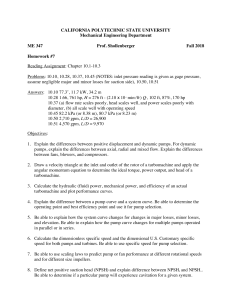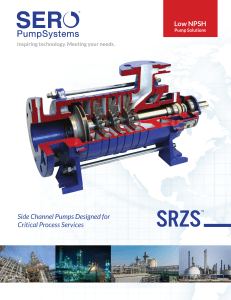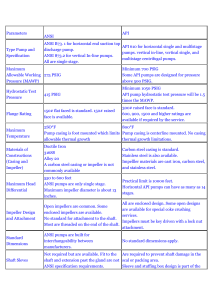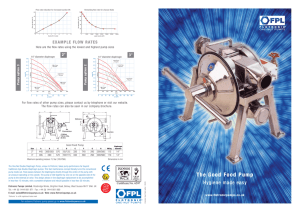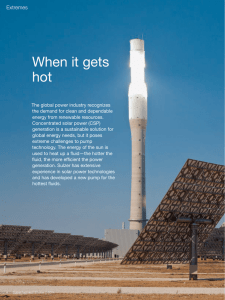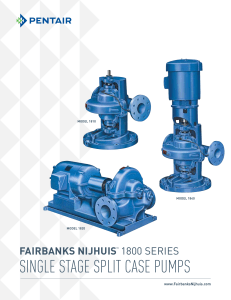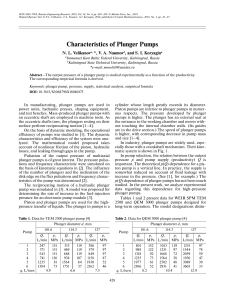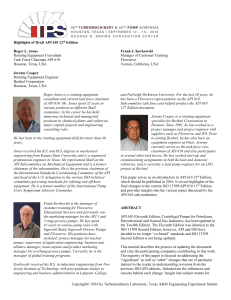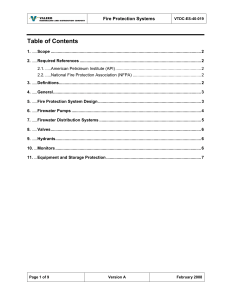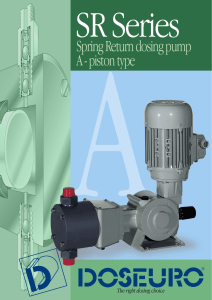Sea Water Heat Pump Project - Alaska Center for Energy and Power
Anuncio
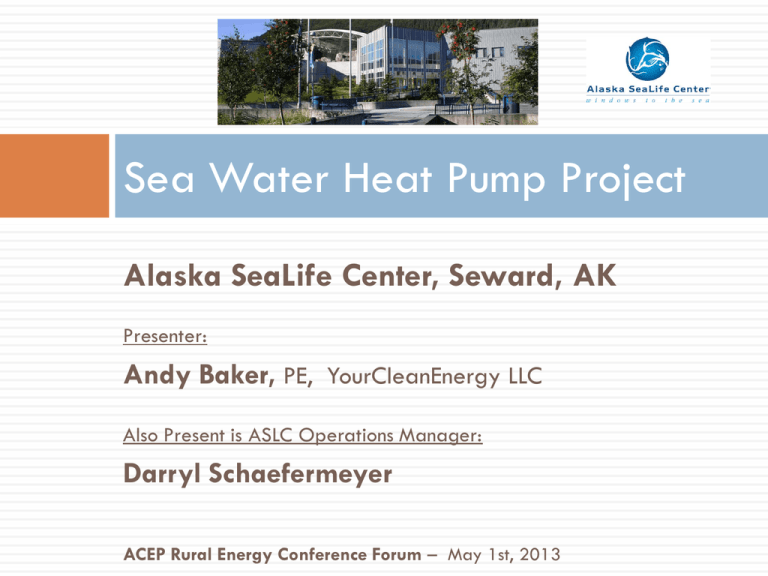
Sea Water Heat Pump Project Alaska SeaLife Center, Seward, AK Presenter: Andy Baker, PE, YourCleanEnergy LLC Also Present is ASLC Operations Manager: Darryl Schaefermeyer ACEP Rural Energy Conference Forum – May 1st, 2013 YourCleanEnergy LLC - Mission History: Providing clean energy consulting (financial evaluation & design) services to commercial and municipal clients in Alaska since 2006. Specialize in sea water heat pump evaluation & design. Successful clean energy projects are ones that are: • Affordable Reliable Safe What Are Sea Water Heat Pumps? Water source heat pumps that tap the ocean directly for heat Not to be confused with Ocean Thermal Energy Conversion Immense solar energy travels 93 million miles from the sun to reach the earth’s surface, where it is both absorbed and reflected Most of the solar heat reaching earth is absorbed directly by the ocean, or indirectly from fresh water flow, or from heated air. In Alaska, many ice free bays have year round sea water temps greater than 35F. This is utility grade heat source ready to tap. Technology Overview Q = Quantity of heat produced by heat pump P = Electrical power used by heat pump COP (Coefficient of performance) of 3.1 – 3.6 expected from ASLC seawater heat pump Water Source vs. Air Source Heat Pumps Alaska SeaLife Center The Alaska SeaLife Center generates and shares scientific knowledge to promote understanding and stewardship of Alaska’s marine ecosystems. Alaska SeaLife Center Economic Profile of the Center $4.77 million in annual payroll 90 year round employees Largest private employer in Seward, and 11th largest on Kenai Peninsula Year round tourism for South Central Alaska: 160,000 visitors/yr Goals = Reduce Energy Cost & Carbon Emissions Energy Use Profile for the 120,000 sq ft Alaska SeaLife Center: Heating loads are large = air handlers, baseboards, duct coils, pavement heating, domestic hot water Two oil fired boilers plus one electric boiler in plant Heating oil demand can exceed 500 gallons per day in winter and up to 132,000 gallons per year. In 2008 with $5/gallon pricing, annual heating costs reached $463,000. Sea Water Heat Pump Project Resurrection Bay is very deep body of water – 900+ ft in large bathtub area Bay is facing due south, receives tremendous solar gain thru summer Bay holds heat because it is not flushed out by ocean currents; tides are mild; some cooling from glaciers and rivers that drain into Bay Seward Sea Water Heat Resource ASLC Raw Seawater Temperatures for 2003-2008 56 Maximum Monthly Seawater Temperature (F) Temperature, Degrees F 51 Average Monthly Seawater Temperature (F) 46 Minimum Monthly Seawater Temperature (F) 41 36 Jul Aug Sept Oct Nov Dec Jan Feb Mar Apr May Jun Storage of solar heat in Resurrection Bay = year round usable heat resource Financial Evaluation - Projected CAPITAL COST: ($713,300 Grant + $120,000 Match) $ 833,300 ANNUAL COST FOR GLYCOL PUMPING: $ 26,000 ANNUAL COST FOR HEAT PUMP ELECTRICITY: $ 63,800 ANNUAL COST FOR O&M: $ 12,000 ANNUAL VALUE OF HEATING OIL SAVED: $ 192,000 NET PRESENT WORTH WITH 20 YR LIFE CYCLE: $ 1,500,000 YEARS TO PAYBACK INVESTMENT: 8.5 YEARS ANNUAL CO2 PRODUCTION AVOIDED: 1.3 million LBS CO2 •Electricity cost = start at $0.104/kwh with 4% per year escalation •Heating oil cost = start at $3.84 /gallon with 6% per year escalation •System running with slab heat connected & heat recovery installed Overall System Operator Screen Actual Installation – Heat Pumps Two 90-Ton Heat Pumps – One or Two Heat Pump Operation Actual Installation – Sea Water HX Transfers Heat From Sea Water Into a Glycol Loop That Then Passes Through Heat Pumps Actual Installation – Loop Pumps High-Efficiency Circulation Pumps Move Glycol and Water Through the Heat Pumps Actual Installation – Air Handler HX Heat Pumps Warm Up Water Loop to 120°F – This Heat is Then Transferred to Air Handler Loop Actual Install – Domestic Hot Water HX City Water Entering at 45°F is Pre-Heated Up To 100°F With a Side Loop From Heat Pumps Actual Installation – Motor Control Center All Electricity Used For Heat Pumps, Circulation Pumps, and Controls is Supplied by One MCC System Performance – Winter 2012/13 Oil boilers turned off December 8, 2013 when main slab heat loop connected to heat pump system Net monthly savings of over $18,000 per month over previous year in months of January, February, March & April 2013 (including electricity for HPs). Total System COP now within 4% of design expectation of 3.0 January 2013 February 2013 March 2013 April 2013 System COP = 2.88 System COP = 2.95 System COP = 2.92 System COP = 3.15 Lessons Learned – Winter 2011/12 Heat pumps operate most efficiently when fully loaded Sidewalk snow melt is a large heat load that was added to heat pump system for winter 2012/13. Four more outdoor slabs will be added for next winter, this will increase system COP further Existing oil boilers are now too large and expensive to hybridize with heat pumps Original HVAC controls for air handlers and boilers require upgrades to increase benefit of low temperature heat from heat pumps Project Status Construction completed July 2011, testing and commissioning phase complete by May 2013. Alaska SeaLife Center is now securing additional funding to improve the base sea water heat pump system: install heat recovery system that uses waste heat from exhaust fans to pre-heat glycol before entering heat pumps; will increase COP, and the investment will payback in less than 3 years Connect additional four outdoor slabs to heat pump system so that further reductions in oil usage will occur in shoulder seasons What is District Heating? District heating = simple and cost effective way to distribute renewable energy heat to buildings for space heating, domestic hot water, and snow melt. Modern district heating = reduce cost of heat below fossil fuels and recycle surplus heat from electricity production, and from industrial processes (sea food refrigeration). District heating with clean hydro and wind power + sea water heat can eliminate regulated emissions & the liability of pollution. Primary benefits of locally owned district heating with sea water heat pumps: - avoid importation of heating oil and its escalating costs (6 to 10% per year expected) - price stability (cost of heat tied mostly to cost of hydro electricity and wind power - produce heat at lower cost than heating oil or electric heat for extended future - Properties along the district loop will increase in value, densification will occur, tax revenues increase - environmental savings – minimal CO2 and polluting emissions, reduced fuel storage and spills Sea Water Heat Pumps - District Heat Sea Water Heat Pumps provide affordable, reliable, and safe alternative to burning organic carbon for building heat Sea Water Heat Pump technology and systems are proven in northern climates, with many examples to learn from Sea Water Heat Pumps allow district heating at low to medium temperatures, without the high energy losses or dangers of steam lines Low to medium temperature heat distribution encourages investments in building envelope efficiency, and installation of low temperature heat distribution (radiant floor, duct coils, pavement heating, domestic how water heating) Proposed Heating District – Downtown Seward SEA WATER HEAT PUMP / DISTRICT HEATING Start with small district - new or existing large public buildings: -Integrate the sea water district heating concept into planning: -Engineering evaluation of viable options -Downtown heating district served by single sea water intake and heat pump station – economy of scale Thank You! Andy Baker, PE YourCleanEnergy LLC Sea Water Heat Pump Project Andy Baker, PE YourCleanEnergy LLC Darryl Schaefermeyer, Operations Manager, ASLC Your Questions About This Project? Please visit your Alaska SeaLife Center in 2013
